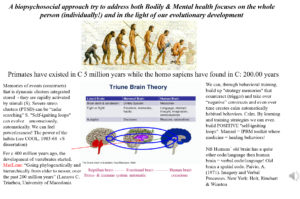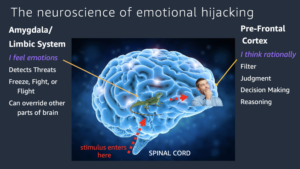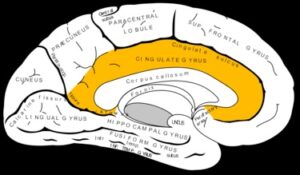Work in progress
For English see below the Swedish text – just inserted (maschin translated so far!
Axiom: Under den biologiska evolutionens sista trehundra tusen år utvecklas homosapiens unika del av vår hjärna. Det skedde genom pålagring av en utveckling som skett genom hundratals miljoner år! Dess utveckling har i sin tur haft en integrerande utveckling som ledde till en successivt ökande evolution nr 2, den kulturella evolution som även utgör en pålagring av vår biologiska evolution – alltså inklusive den neurobiologiska evolutionen i termer av en fortsättning på primaternas hjärnas utveckling.

Än mer komplicerat: Det typiska unika för den moderna homosapiens är verbalt språk och rationellt resonerande som även ger ett tidsperspektiv (bakåt, nu och framåt i tiden), förutom metakognition (att ovan ifrån försöka observera sig själv) och utveckla självperspektiv/självinsikt och därmed också kritiskt tänkande. Jmf “tales princip” Vetenskap | Stressmedicinsk Centrum (stressmedcenter.com)
Vem/vad bestämmer – vår del av hjärnan (”mänskliga” delen) som utvecklats sista 300.000 åren eller Limbiska systemet som har flera hundra miljoner på nacken?
Medan minnen och emotioner till stor del styr även stora delar av våra fundamentala biologiska processen, styr den i mycket också i vårt dagliga liv. Det gäller inte bara det vi brukar kalla ”autopiloten” utan mycekt av vårt beteende som vi (ofta) tror är vad vi rationellt styr över. ”Emotional intelligence” (ett populärt koncept) är inte relevant för vår diskussion* utifrån ett evolutionärt perspektiv utan vanligen Limbiska beteenden beror på vilka minnekonstrakt/kluster det genereras där äldre delar kan ”järnstressa oss” – nedan är den bästa beskrivning jag sett som stämmer in med vårt paradigm

https://www.richardhua.co/why.html
(Maskinöversatt) “Vi kan bli kapade känslomässigt på grund av hur våra hjärnor utvecklats från ett evolutionärt perspektiv.
1. Alla stimuli in i vår hjärna genom basen och
2. Passera genom vårt limbiska systemet först. Det är den del av hjärnan som upptäcker hot och berättar för dig att kämpa, fly eller frysa. Det är också sätet för dina känslor. Signalen går först till amgydala och sedan till
- Pre-frontala (och neo-) cortex där du har rationell tanke och resonemang.
När stimulansen är riktigt stark, kan amygdala bokstavligen ”kapa” hjärnan och stänga ner centra för rationell tanke för att utföra en omedelbar, visceral reaktion. Fight eller flyg hormoner utsöndras, och det kan ta 6 till 10 sekunder för pre-frontala cortex att komma tillbaka online. Det var bra för att fly från saber-tand tigrar på Savannah … men inte så bra för att svara på din chef när de säger något du inte gillar. Det är därför du behöver lära dig att hantera dina känslor på ett hälsosamt och produktivt sätt!”
BvS-> fortsätter … Limbiska baserad aktiviteter kan vi se när vi medvetet med strategier påverkar icke med medvetna system som autonoma nervsystemet som är en av våra viktigaste fokus inom integrerad biofeedback se till exempel om hypertension och hur patienter egen tränar för att normalisera sitt för höga blodtryck med sist stress finger temperatur.
*Eftersom detta koncept definieras som något positivt, konstruktivt (som dock börjar få kritik, t.ex. ” Can emotional intelligence be used negatively? Recent studies have identified a variety of contexts where emotional intelligence isn’t helpful, and may even have a negative intrapersonal or interpersonal effect. [3] Put simply, it could be harming our relationships with ourselves and others – The dark side of emotional intelligence” https://mindtoolsbusiness.com/resources/blog/the-dark-side-of-emotional-intelligence – The Science Behind Emotional Intelligence https://www.hrdpress.com/site/html/includes/items/SBEI.html#:~:text=The%20emotional%20brain%20(limbic%20system,have%20%E2%80%9Clearned%E2%80%9D%20from%20experience.
The above gives a more relevant picture partly corresponding our evolutionary based approach, e.g. “The emotional brain (limbic system) helps us know what things to approach and what to avoid by guiding our preferences. As we move through life and have more experiences, we have stronger intuitions, hunches, and gut reactions because more things are stored in the limbic warehouse. We have “learned” from experience.” – https://www.hrdpress.com/site/html/includes/items/SBEI.html#:~:text=The%20emotional%20brain%20(limbic%20system,have%20%E2%80%9Clearned%E2%80%9D%20from%20experience.
Mer om LAOB (ej OCD ordet – se nedan!)
Inom integrerat psykofysiologiskt beteendemedicinskt paradigm (se …) närmar vi oss LAOB ur ett ”inte-OCD” -perspektiv, det vill säga ”ordet / konceptet OCD”, som bygger på ett mycket begränsat (om något) evolutionärt biopsykosocialt medicinsystem som integrerar utgångspunkt, heter härifrån inte OCD utan Limbic Overacting Automatic Behaviors (LOAB). Under den vetenskapliga plattformen för ett sådant (r)evolutionärt praktiskt användbart tillvägagångssätt för patienter, som ska användas i handboken ”patient som en rimlig kompetent utbildad (av certifierade kliniker) resurs och medarbetare i egen rehab” (von Scheele, 1997, kliniskt manuskript)
Först några (just nu för komplexa) om grundläggande kunskaper:
The anterior cingulate cortex (ACC) in patients with (OCD) has been found to be hyperactive
https://pubmed.ncbi.nlm.nih.gov/12807408/

Medial surface of left cerebral hemisphere, with cingulate gyrus and cingulate sulcus highlighted
(Maskin översatt) “Den främre cingulära cortexen (ACC) hos patienter med tvångssyndrom (OCD) har visat sig vara hyperaktiv i vila, under symptomprovokation och efter fel i kognitiva uppgifter. Denna hyperaktivitet kan återspegla en abnormitet i konfliktdetektering, en hypotetisk grundläggande mekanism för ACC: s åtgärdsövervakningsfunktion. Denna hypotes testades med hjälp av funktionell magnetisk resonansavbildning genom att skanna 11 OCD-patienter och 13 matchade kontrollpersoner medan de utförde en version av den kontinuerliga prestandauppgiften med fyra försökstyper som inducerade graderade nivåer av svarskonflikt. Även om ett beteendeindex för konflikt (dvs. noggrannhet) var liknande för patienter och kontrollpersoner, ökade ACC-aktiveringen hos patienter under studier med hög konflikt. Den felrelaterade aktiviteten i samma hjärnregion var också högre hos patienter, i överensstämmelse med tidigare elektrofysiologiska fynd. Både konflikt- och felrelaterad aktivitet visade trender för positiva korrelationer med svårighetsgraden av OCD-symtom, men inte med ångest. Dessa resultat tyder på att ACC som en del av ett överaktivt åtgärdsövervakningssystem är mer direkt involverat i patofysiologin för OCD än man tidigare trott”
BvS-> Vi kan tillägga att detta i grunden har med grundläggande (lång tidigare i evolutionen av vår hjärna ACC och Limbiska systemet, d.v.s. basala överlevnadsmekanismer att göra och då Retikulära aktiverings Systemet (RAS). Alltså, i princip ett överlevnadsbeteende som inte passar in i den moderna homo sapiens nutida livssituation!
Denna utgångpunkt får hela andra konsekvenser för utredningar och interventioner inklusive deras kontinuerliga uppföljning med integrerade psykofysiologiska beteendemedicinska laboratorium mätningar, i en enkel version kan patienter själva (som medarbetare!) genomföra mätningar själva – något de lär sig vid utbildning av den biopsykosociala medicinska manualens verktygslådan och motiverande kunskapsplattform
I underflikar kommer ingående beskrivning av metodologi och teknologi för praktisk klinik användning!
What does the cingulate gyrus do in the limbic system?
“An important part of the limbic system, the cingulate gyrus helps regulate emotions and pain. It is also involved in predicting and avoiding negative consequences. An important part of the limbic system, the cingulate gyrus helps regulate emotions and pain.” https://dnalc.cshl.edu/view/2106-Cingulate-Gyrus-.html
BvS-> Ovan kan vidare utvecklas när vi mer ingående beskriver hur minnes kluster uppdateras och ”av egen kraft” kan kontrollera våra beteende, något som också kan visas i hypnosexperiment som inte ofta diskuteras av skäl som kan förmodas störa läkemedelsanvändning som inte har bäring på ovan ”reversed perspective”. Se mer i underflikar (som planeras att läggas in under hösten 2022 – texter från c 30 års klinisk bearbetning av det som nu presenteras i uppdaterad form)
… Kommer mera …
ENGLISH
Axiom: In the last three hundred thousand years of biological evolution, the unique part of homosapien of our brain develops. It was done by piling on an evolution that has taken place over hundreds of millions of years! Its evolution, in turn, has had an integrative evolution that led to a progressively increasing evolution No. 2, the cultural evolution that also constitutes an imposition of our biological evolution – thus including neurobiological evolution in terms of a continuation of the primates’ brain development.

Even more complicated: The typical uniqueness of modern homosapiens is verbal language and rational reasoning that also provides a time perspective (backwards, now and forwards in time), in addition to metacognition (trying to observe oneself above) and develop self-perspective / self-insight and thus also critical thinking. Cf. ”spokes principle” Science | Stress Medicine Center (stressmedcenter.com)
Who/what decides – our part of the brain (”human” part) that evolved over the last 300,000 years or the Limbic system that has several hundred million on its neck?
While memories and emotions largely control even large parts of our fundamental biological process, it controls in many things in our daily lives as well. This applies not only to what we usually call the ”autopilot” but to the mycekt of our behavior that we (often) believe is what we rationally control. ”Emotional intelligence” (a popular concept) is not relevant to our discussion* from an evolutionary perspective, but usually Limbic behaviors depend on what memory abstracts/clusters it is generated where older parts can ”iron stress us” – below is the best description I have seen that fits with our paradigm
NB se second picture above
We can get emotionally hijacked because of how our brains developed from an evolutionary perspective. All stimuli enter our brain through the base and pass through our limbic system first. That’s the part of the brain that detects threats and tells you to fight, flee, or freeze. It’s also the seat of your emotions. The signal first goes to the amgydala and then to the pre-frontal cortex where you have rational thought and reasoning.
When the stimulus is really strong, the amygdala can literally ”hijack” the brain and shut down the centers for rational thought in order to execute an instant, visceral reaction. Fight or flight hormones are secreted, and it can take 6 to 10 seconds for the pre-frontal cortex to come back online. That was great for escaping from saber-tooth tigers on the Savannah…but not so great for responding to your boss when they say something you don’t like. That’s why you need to learn to manage your emotions in a healthy and productive way!
BvS > continues… Limbic based activities we can see when we consciously with strategies influence non-conscious systems such as the autonomic nervous system which is one of our main focuses in integrated biofeedback see for example about hypertension and how patients own train to normalize their too high blood pressure with last stress finger temperature.
*Because this concept is defined as something positive, constructive (which, however, begins to receive criticism, e.g. ” Can emotional intelligence be used negatively? Recent studies have identified a variety of contexts where emotional intelligence isn’t helpful, and may even have a negative intrapersonal or interpersonal effect. [3] Put simply, it could be harming our relationships with ourselves and others – The dark side of emotional intelligence” https://mindtoolsbusiness.com/resources/blog/the-dark-side-of-emotional-intelligence – The Science Behind Emotional Intelligence https://www.hrdpress.com/site/html/includes/items/SBEI.html#:~:text=The%20emotional%20brain%20(limbic%20system,have%20%E2%80%9Clearned%E2%80%9D%20from%20experience. Gives a more relevant picture partly corresponding our evolutionary based approach, e.g. ”The emotional brain (limbic system) helps us know what things to approach and what to avoid by guiding our preferences. As we move through life and have more experiences, we have stronger intuitions, hunches, and gut reactions because more things are stored in the limbic warehouse. We have ”learned” from experience.”
More about LAOB (not the OCD word – see below!)
Within the integrated psychophysiological behavioral medicine paradigm (see …), we approach LAOB from a ”not-OCD” perspective, that is, the ”word / concept OCD”, which is based on a very limited (if any) evolutionary biopsychosocial medicine system that integrates starting point, from here is called not OCD but Limbic Overacting Automatic Behaviors (LOAB). Under the scientific platform of such an (r)evolutionarily practically useful approach to patients, to be used in the manual ”patient as a reasonably competently trained (by certified clinician) resource and collaborator in self-rehab” (von Scheele, 1997, clinical manuscript)
First, a few (right now still too complex) about basic knowledge:
The anterior cingulate cortex (ACC) in patients with (OCD) has been found to be hyperactive
https://pubmed.ncbi.nlm.nih.gov/12807408/
NB see picture 3 above!
Medial surface of left cerebral hemisphere, with cingulate gyrus and cingulate sulcus highlighted
”The anterior cingulate cortex (ACC) in patients with obsessive-compulsive disorder (OCD) has been found to be hyperactive at rest, during symptom provocation, and after commission of errors in cognitive tasks. This hyperactivity might reflect an abnormality in conflict detection, a hypothesized basic mechanism for the action-monitoring function of the ACC. This hypothesis was tested using functional magnetic resonance imaging, by scanning 11 OCD patients and 13 matched control subjects while they performed a version of the continuous-performance task with four trial types that induced graded levels of response conflict. Although a behavioral index of conflict (i.e., accuracy) was similar for patients and control subjects, the ACC activation was increased in patients during high-conflict trials. The error-related activity in the same brain region was also higher in patients, consistent with previous electrophysiological findings. Both conflict- and error-related activity showed trends for positive correlations with severity of OCD symptoms, but not with anxiety. These findings suggest that as part of an overactive action-monitoring system, the ACC is more directly involved in the pathophysiology of OCD than previously thought.”
BvS-> We can add that this basically has to do with fundamental (long earlier in the evolution of our brain ACC and limbic system, i.e. basal survival mechanisms to do and then the Reticular Activation System (RAS). Thus, basically a survival behavior that does not fit into the modern homo sapiens contemporary life situation!
This starting point has completely different consequences for investigations and interventions including their continuous follow-up with integrated psychophysiological behavioral medicine laboratory measurements, in a simple version patients themselves (as collaborators!) can carry out measurements themselves – something they learn when training the biopsychosocial medical manual’s toolbox and motivational knowledge platform
In the sub-tabs comes a detailed description of the methodology and technology for practical clinic use!
What does the cingulate gyrus do in the limbic system?
”An important part of the limbic system, the cingulate gyrus helps regulate emotions and pain. It is also involved in predicting and avoiding negative consequences. An important part of the limbic system, the cingulate gyrus helps regulate emotions and pain.” https://dnalc.cshl.edu/view/2106-Cingulate-Gyrus-.html
The BvS > Above can further be developed as we describe in more detail how memory clusters are updated and ”by their own power” can control our behavior, something that can also be shown in hypnosis experiments that are not often discussed for reasons that can be assumed to interfere with drug use that does not have bearing on the above ”reversed perspective”. See more in sub-tabs (which are planned to be added in autumn 2022 – texts from c 30 years of clinical adaptation of what is now presented in updated form)
… Will more. come ..
